Springboks’ blitz defence showed England how to contain Finn Russell

Containing the creativity and skill of Finn Russell is no mean feat. The 31-year-old has now started some 240 competitive matches as a top-level fly-half for Glasgow Warriors, Racing 92, Bath, Scotland and the British and Irish Lions. Only three times in those games have his teams been restricted to three points or fewer.
One such occasion, following Ireland’s 27-3 win over Scotland in 2019 and Racing’s 19-0 loss to La Rochelle two and a half years later, was a World Cup pool match against the Springboks in Marseille. While Jacques Nienaber is regarded as the mastermind of South Africa’s defence between 2018 and 2023, Felix Jones was an important figure. The pair dovetailed closely. Indeed, for this game at Stade Vélodrome, they were sitting side by side:
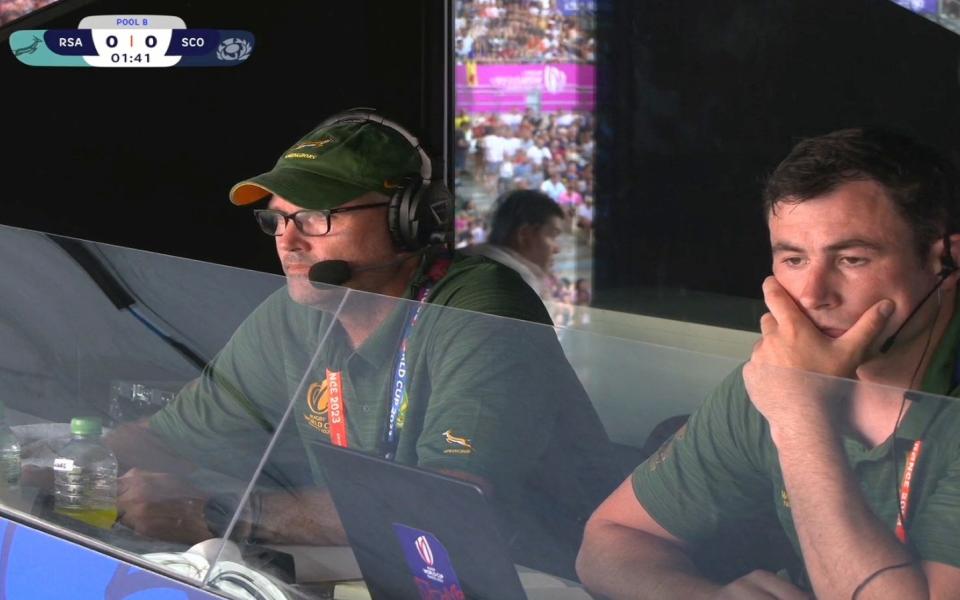
Even in the two fixtures since Jones’ arrival, England’s commitment to changing their defensive system has been palpable. They are clearly attempting to rush, ruffle and disrupt opponents as the Springboks have done. In that respect, given England head to Murrayfield this weekend, they may well heed some lessons from South Africa’s performance five months ago. On that humid afternoon, the Springboks aimed to compromise Scotland’s line-out platform and hoist contestable kicks into the back-field. They would eventually gain ascendancy in the scrummaging exchanges, too.
Perhaps most significant, however, was how they pressurised Scotland, targeting key decision-makers and dictating matters with aggressive, focused line-speed. South Africa were disciplined, not only in how they stuck to their tactical template but also in that they conceded just seven penalties. Scotland spent only 62 rucks in possession, losing four of them.
England may not be capable of replicating the same dynamism and intensity. But reviewing the game certainly reinforces the influence that elite blitz defences can exert.
Tone-setting (and riding luck)
At the very start of the match, South Africa win back the kick-off after Damian Willemse goes up against Blair Kinghorn, and Scotland have their first throw within a minute after Manie Libbok’s kick-pass towards Cheslin Kolbe bobbles into touch.
Generally, the Springboks were happy to surrender the front of the line-out in this game and Jamie Ritchie rises to claim George Turner’s throw. Russell hides behind Rory Darge, but Franco Mostert spots him…
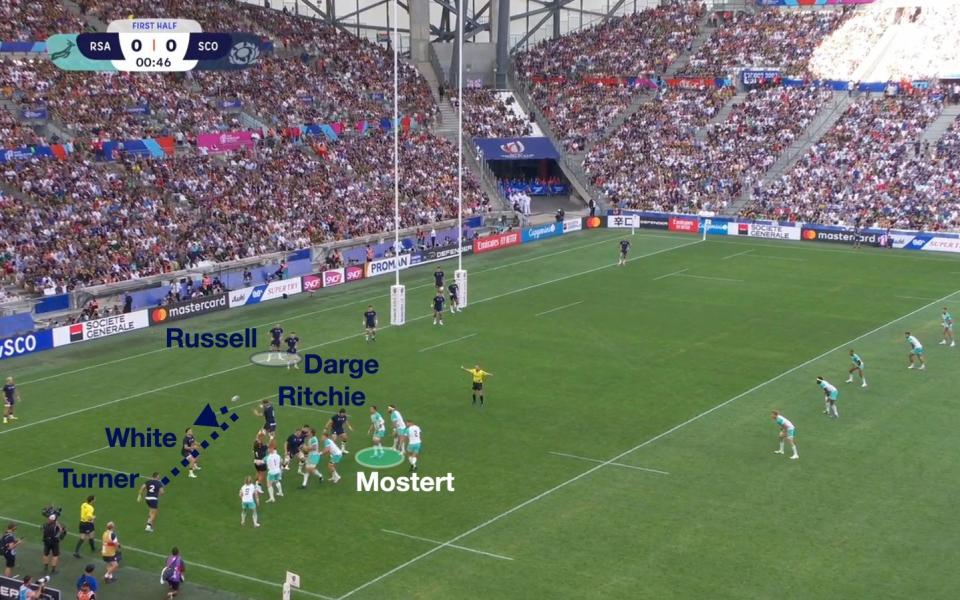
…and presses up to charge-down the clearance:

Minutes later, a pivotal flashpoint arrives. Although Willemse’s chip bounces in front of Kinghorn, Scotland regather. Look at where Jack Dempsey and Jesse Kriel begin:
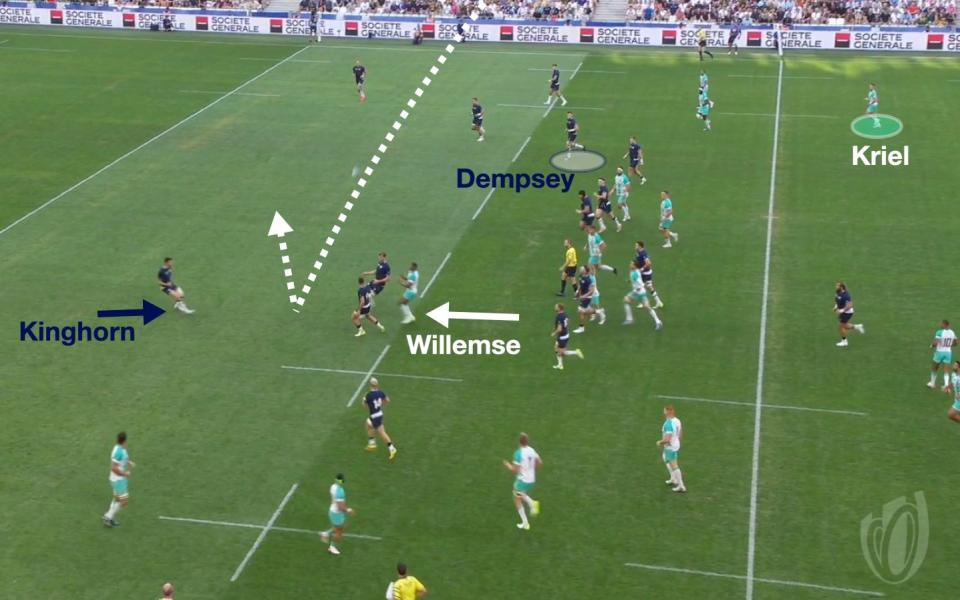
South Africa were obviously wary of Scotland moving the ball from their own half, and Kriel shoots up when Russell goes wide. Kriel stays upright and appears to clash heads with Dempsey, who absorbs the impact and offloads to Huw Jones:

The television match official, Ben Whitehouse, cleared this incident with Angus Gardner while play continued. Had Dempsey received medical treatment, the collision would have been examined more carefully. In the final, after being tackled high by Siya Kolisi, Ardie Savea stayed down. This gave the officials scope to survey that challenge. Eventually, Kolisi was sin-binned.
Dempsey seems totally unruffled here, it should be said, and the Springboks keep their full complement. Kriel would be a critical part of South Africa’s game plan.
In the 15th minute, on the back of a collapsed maul, Scotland have their first opportunity to attack inside opposition territory and set up a typical ‘slide’ shape, with Russell and Duhan van der Merwe arcing behind Sione Tuipulotu and Huw Jones.
Russell is attempting to deceive South Africa with his casual body language, making it look as though he will not be part of the play. The Springboks do not buy it. Libbok and Kriel are the ones to watch:
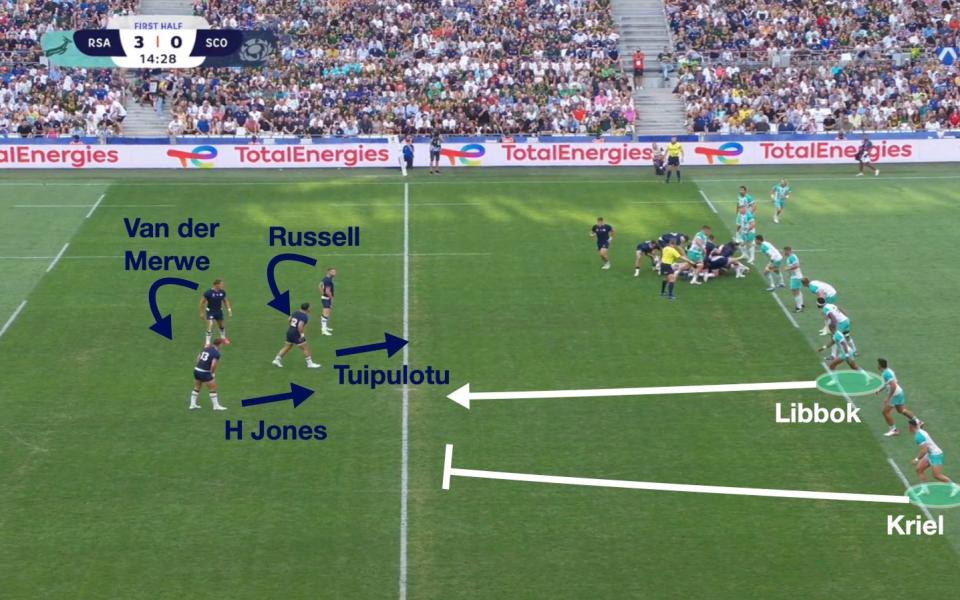
Both lead the line, Libbok swimming past Tuipulotu to Russell and Kriel getting level with Scotland’s fly-half. This cuts off a short ball to Van der Merwe and, with Kolbe also pressing, adds more risk to a longer pass. Russell holds on. Even though he shakes off Libbok, Damien de Allende completes the tackle. Ben White must mop up an offload and is cut down by Mostert:

On the next phase. Scotland head towards the far touchline. They have players on their feet, but watch Eben Etzebeth, Faf de Klerk and Kurt-Lee Arendse:
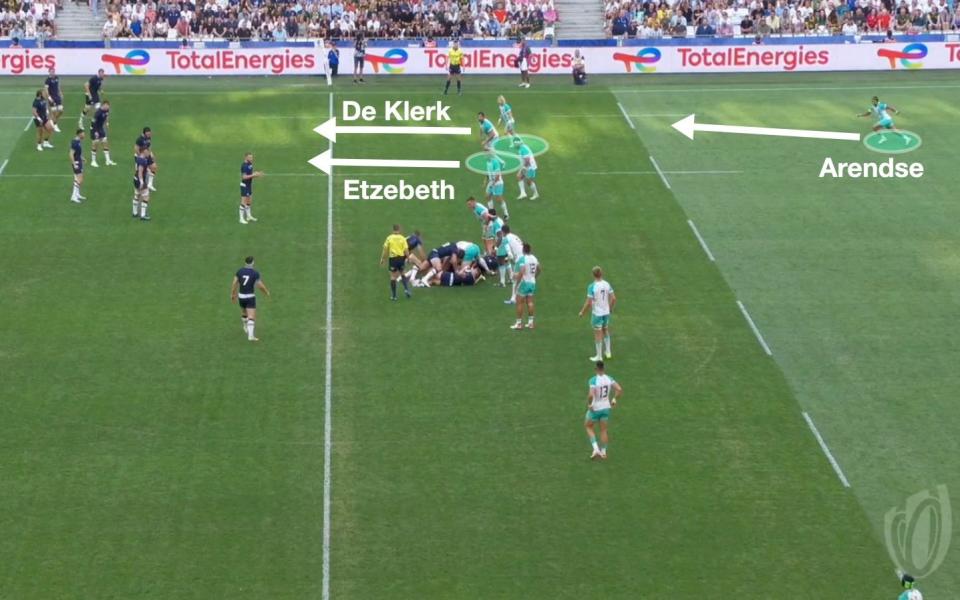
All three press. As Zander Fagerson receives a pass, he is funnelled back inside by the presence of Etzebeth:
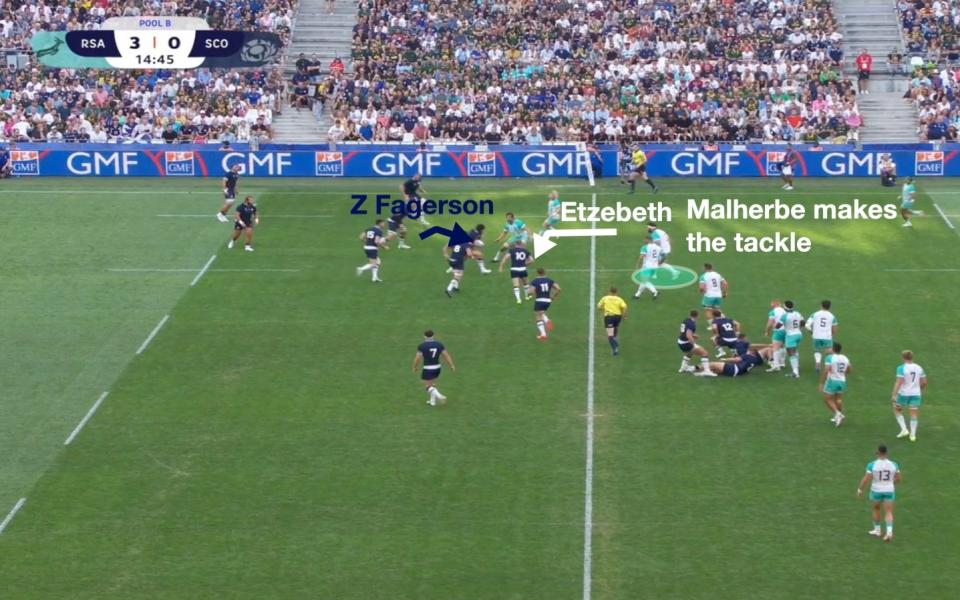
Two phases later, more line-speed from Kriel cuts off Russell’s wider options. Russell goes to the boot, and is charged-down by Pieter-Steph du Toit and De Allende completes the turnover:

White’s kicking is vital for Scotland. Across the first two rounds of the current Six Nations, the Toulon scrum-half has the third most kicking metres of all players, with 821. Only James Lowe (942) and Russell (1,583) are above him. Back in September, South Africa identified the importance of White’s boot. Etzebeth charged him down here, at the beginning of the second quarter:
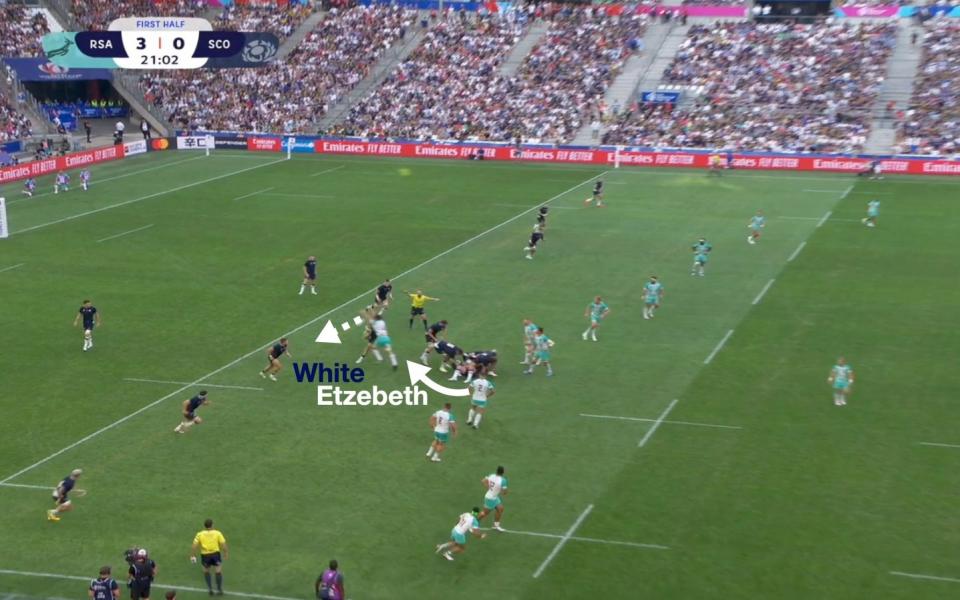
They continued to squeeze, too. Kolbe’s chase of De Klerk’s box-kick here is superb:
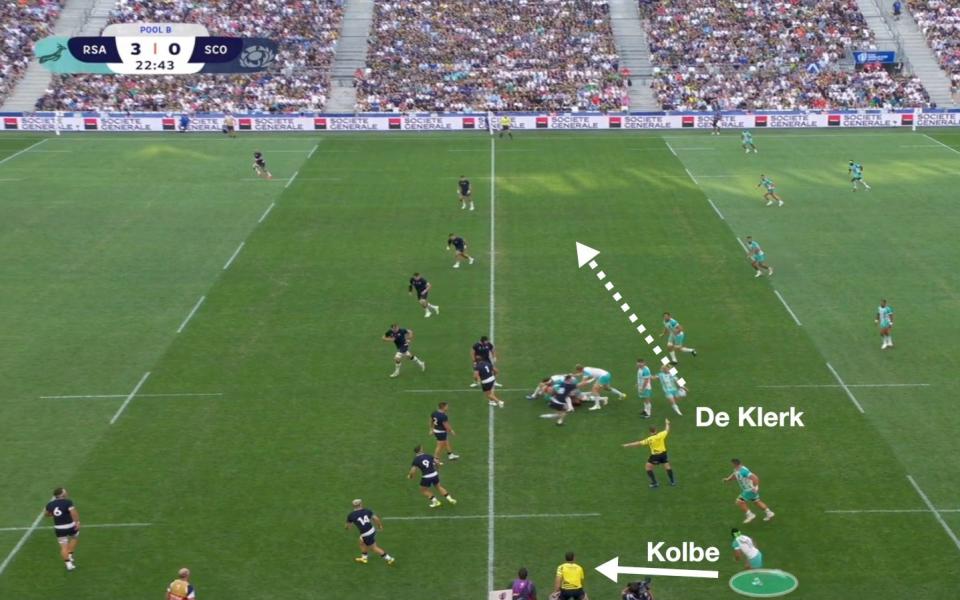
He lassoes Russell and then Tuipulotu, who is pounced upon by Malcolm Marx to concede a penalty that brings three points:

Even when Gregor Townsend’s charges eventually found some impetus down the other end of the pitch, South Africa shackled them.
Precision scramble and a violent pendulum
Jasper Wiese loses the ball from a restart, coughing up a chance for Scotland to respond. Grant Gilchrist steps up at first-receiver, with Russell hanging deeper. Again, Jesse Kriel is the crucial defender:
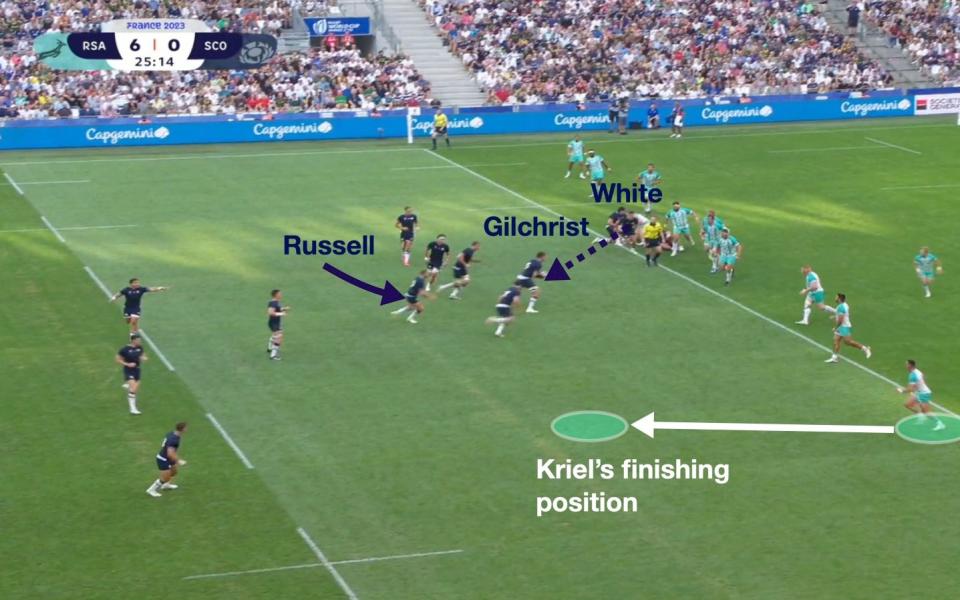
He presses up and holds his ground to cut off a long pass. There is a classic dog-leg here, because Kriel is far ahead of De Allende. But this is where the next layer of the Springboks system comes in. Kolbe reads the situation and swoops rapidly in behind Kriel. Though Jones spies a passing lane for Russell…
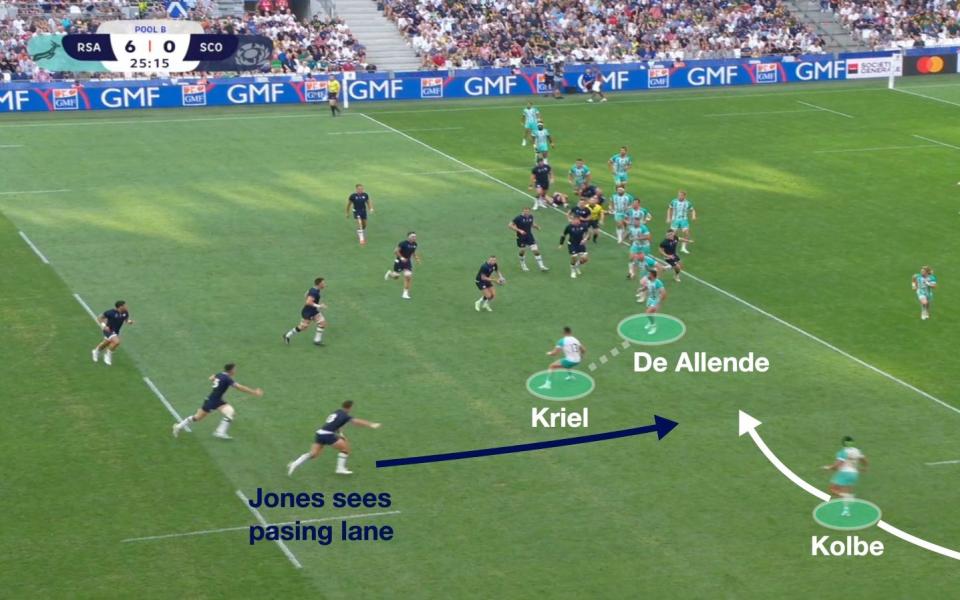
…and Russell obliges, Kolbe readjusts brilliantly. He darts back and would have tackled Jones had the latter managed to keep hold of the pass:

This close-up shows just how far Kolbe has turned before Russell has released the ball. It also demonstrates that Willemse is covering Kolbe’s outside shoulder in a pendulum action and that De Klerk is sweeping around as well:
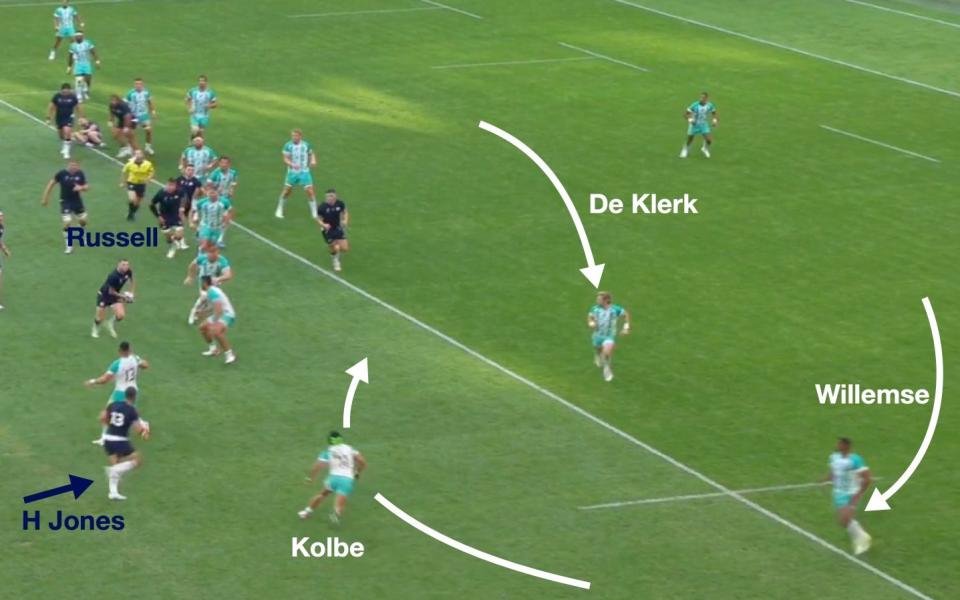
Play comes back for a scrum and Scotland go wide towards the near touchline. Watch how De Klerk and Arendse begin to track in-field as the ball travels towards Darcy Graham:
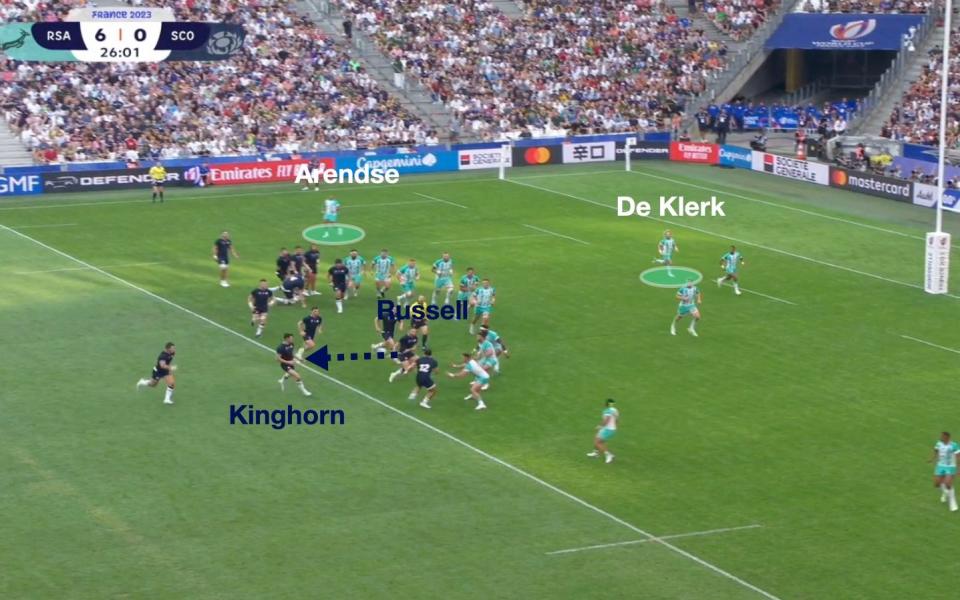
Both are behind the offside line for the next phase. De Klerk spies Tuipulotu as a key distributor:
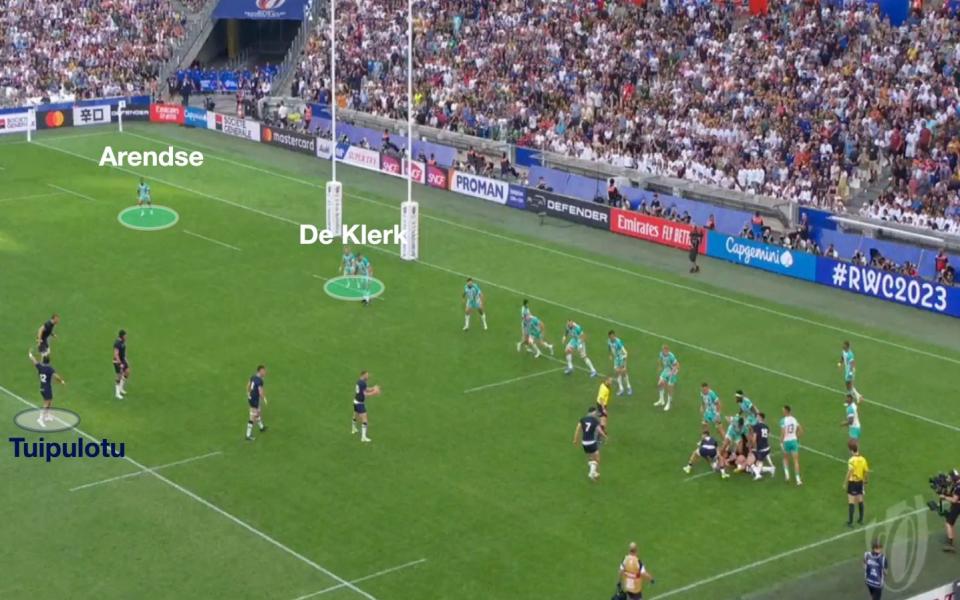
He sprints up, accelerating on Russell’s pass. Tuipulotu beats De Klerk, yet rushes the next pass. Arendse can follow the ball and almost intercepts:

This is calculated line-speed, which helps South Africa escape despite a numerical disadvantage. Moments later, they are in an even more perilous scenario as Scotland split them open.
Up to the gain-line and back again
Close to the half-hour mark, Turner throws over the top and Scotland execute a slick wrap-around that beats Kriel’s press. Tellingly, White comes from the line-out to loop Tuipulotu and feeds Russell behind Huw Jones’ decoy. Russell puts Graham in the clear:

Remember that Libbok is opposite Tuipulotu…
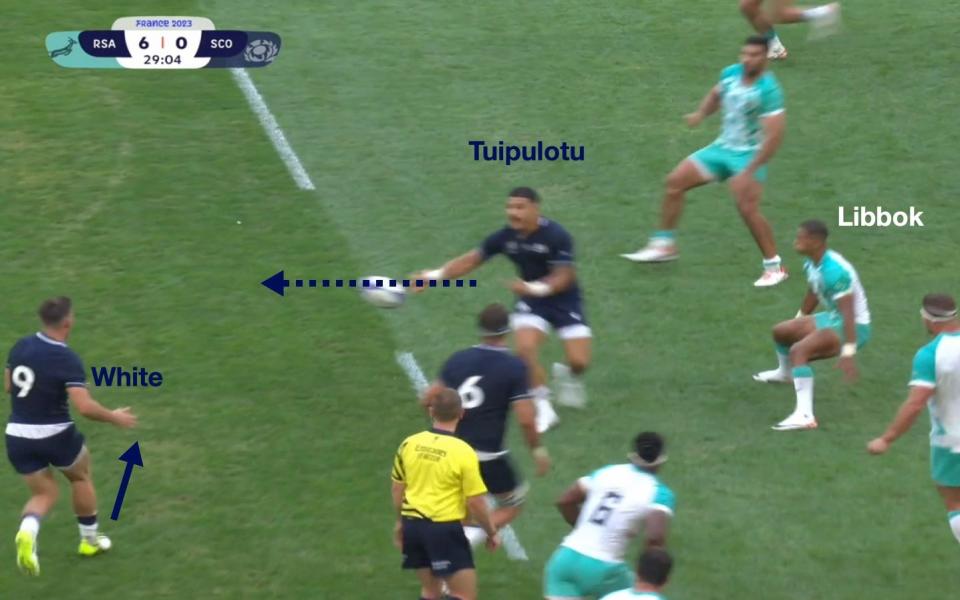
…but readjusts to chase down Graham. Here, he points towards Willemse, telling the full-back to keep drifting:
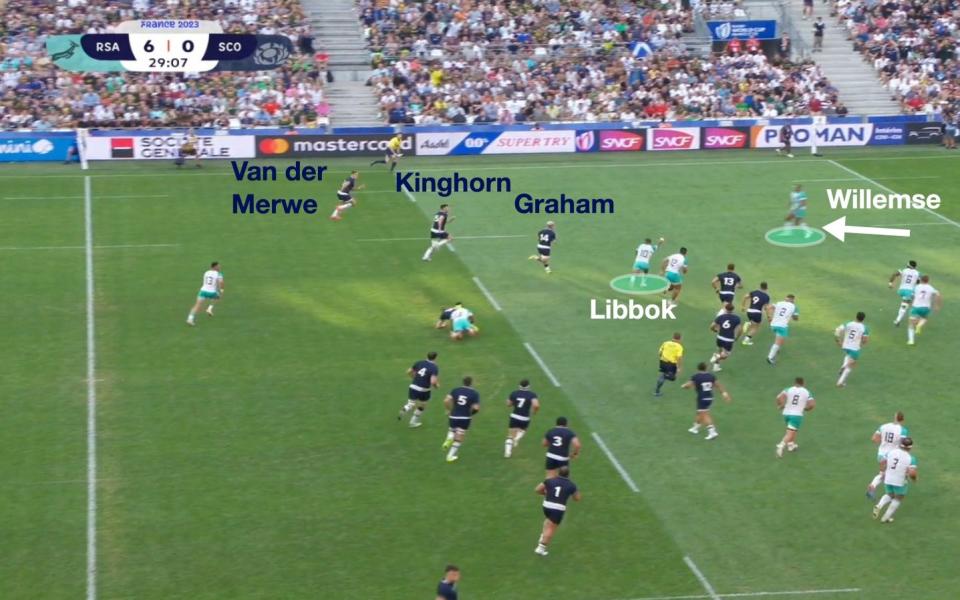
As it happens, Willlemse goes for the intercept rather than stepping in, which would have surely encouraged Graham to pass to Van der Merwe. That little delay allows Libbok to cut down the carrier. Note how De Allende is on the scene to burrow in and slow the breakdown:

South Africa regroup, and stifle Scotland. Two phases later, Scotland’s attacking shape is flat. Watch Du Toit:
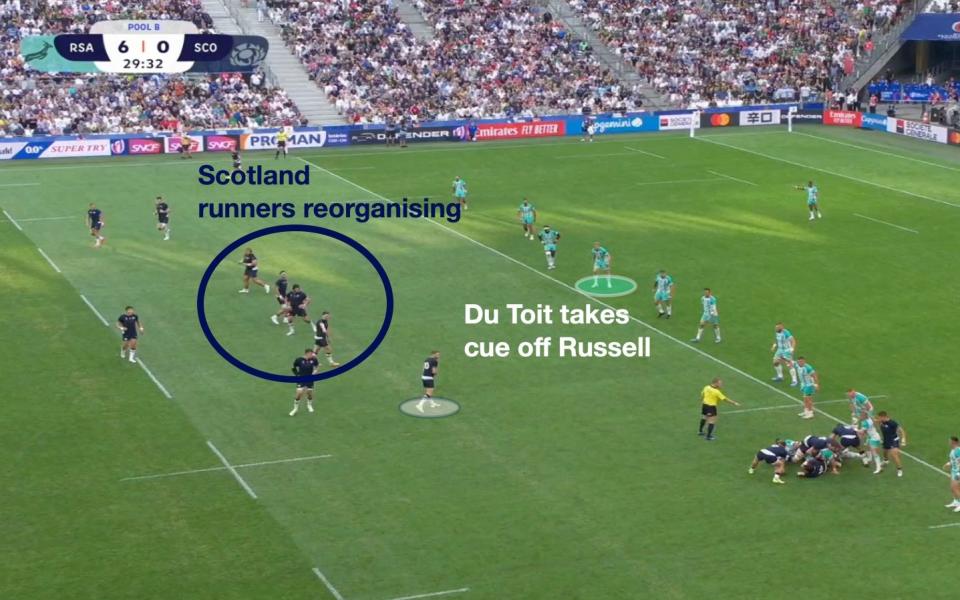
He presses up with White’s pass to Russell and then follows the ball to Zander Fagerson, making a tackle way behind the gain-line. Marx addresses the ball…

...and Wiese completes the turnover.
Moments later, Scotland again attempt to go wide from deep, as Russell spots a narrow defensive line. Arendse is so agile on the edge, though. While he seems to be giving up space here…
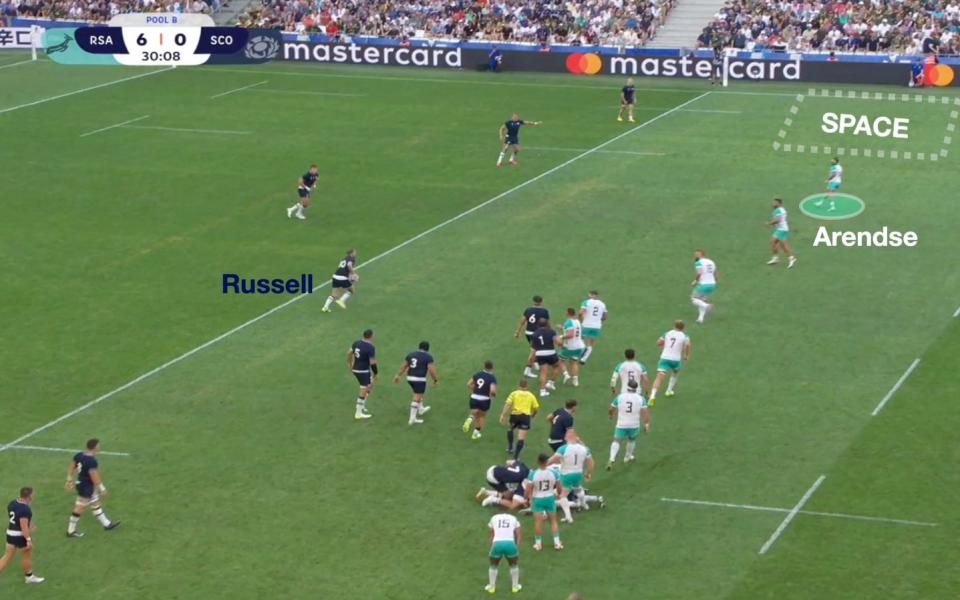
…he changes direction fast. The ball sails over Graham and into touch:

After half-time, South Africa turn the screw.
Scoring in transition and playing with a lead
Surviving a resurgence from Scotland at the end of the first period, inspired by the scrummaging of Zander Fagerson and Pierre Schoeman, South Africa scored early in the second half to go 11-3 up.
From this line-out, Libbok leads the press and Dempsey is stopped in midfield:
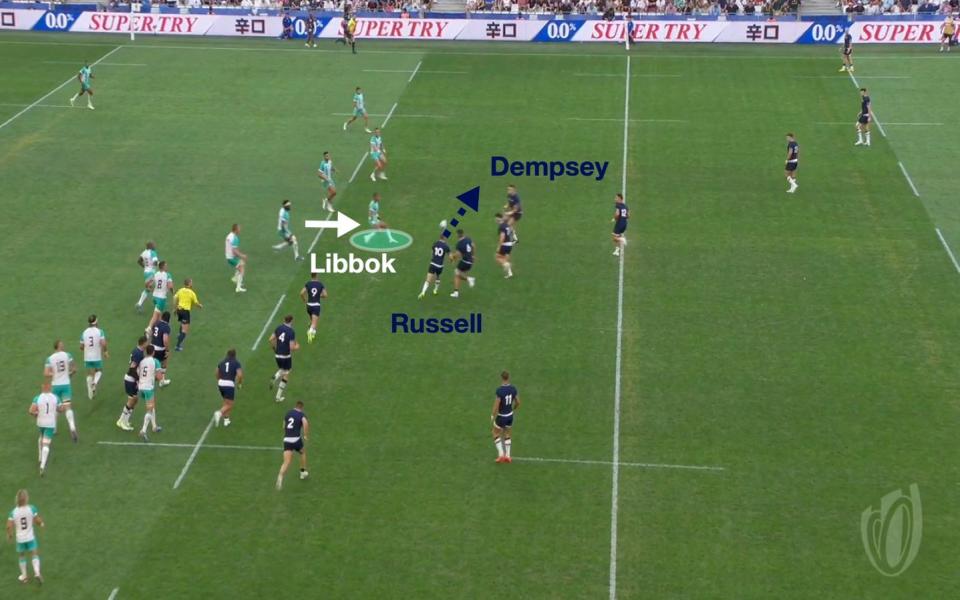
Du Toit presses up to funnel Turner back inside on the next phase:
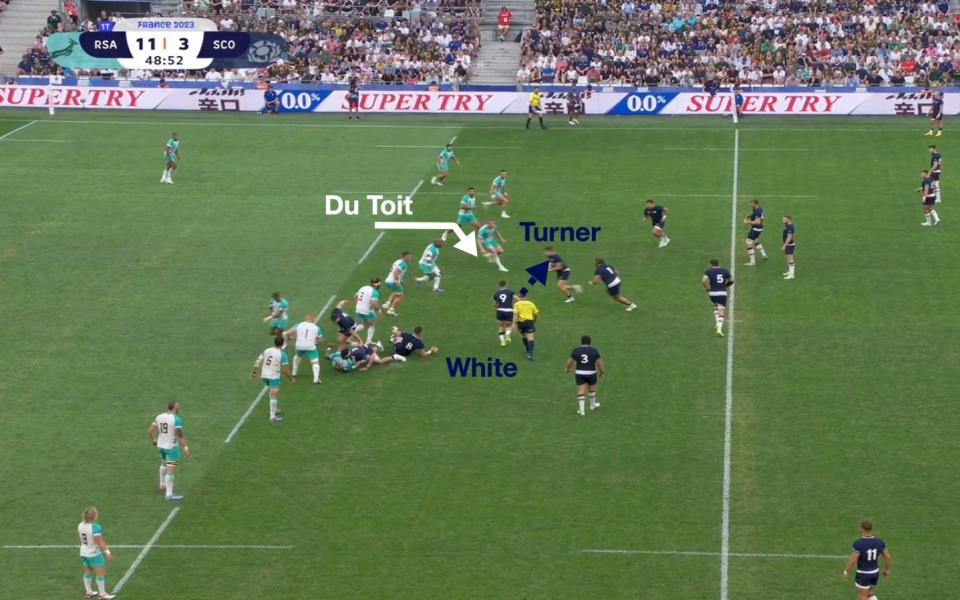
Scotland then bounce back against the grain and attempt a dummy wrap-around trick play, with Dempsey throwing an inside pass to Huw Jones, that is also halted by heavy tacklers close to the ruck. Watch how Libbok and De Klerk keep pressing:
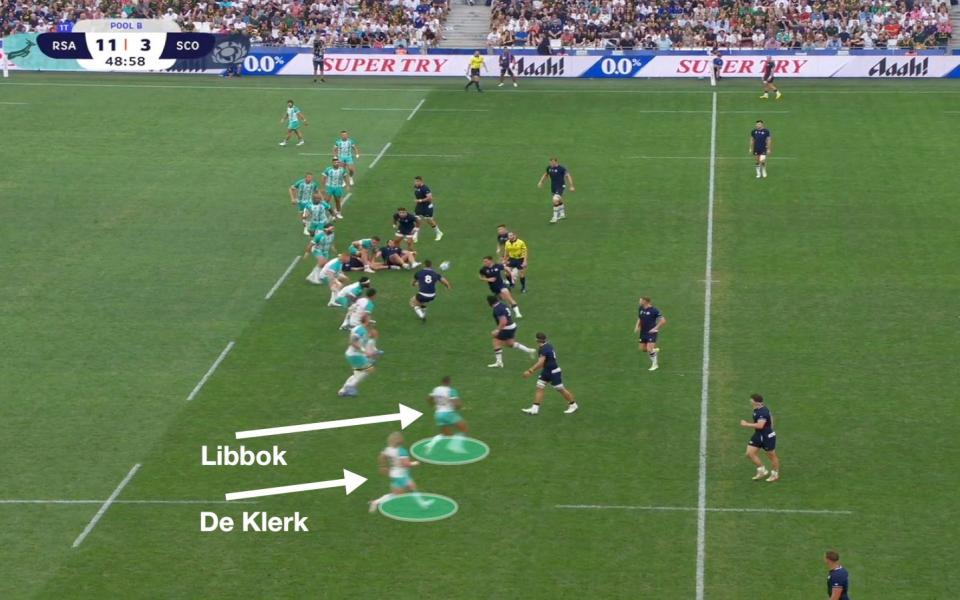
On the next phase, Russell steps up at first-receiver. De Klerk sprints out of the line and causes Russell to drop off a short pass to Ritchie. RG Snyman drags down the Scotland skipper and Steven Kitshoff jackals. Darge, White, Van der Merwe and Zander Fagerson must all commit to the breakdown just to keep possession:

Now watch Kriel. Though Scotland have width in their attack…
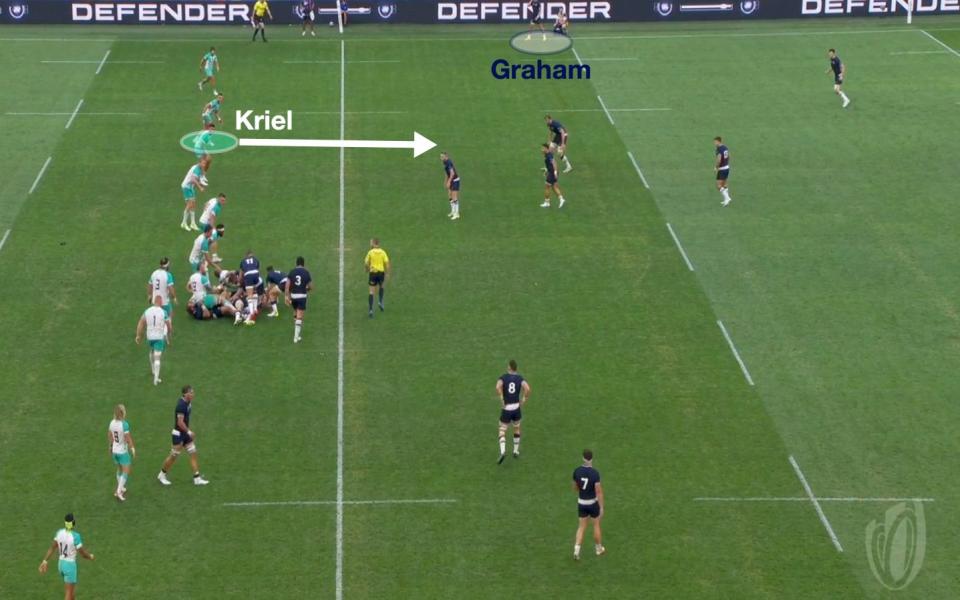
…Kriel’s line-speed cuts off that width and persuades Russell to feed a flat pass to Richie Gray. De Allende tackles the carrier and Wiese forces the turnover. He initially jackals before marching past the ball:

Gardner could penalise the back-rower for failing to support his bodyweight, but the turnover is allowed and South Africa strike brilliantly. Libbok’s no-look kick-pass to Arendse is a perfect example of how to find space in transition:
Nienaber’s blitz defence has been so effective because it alters the picture in a split-second. Later, with Scotland trailing 18-3, Russell takes the ball at first-receiver from a line-out. He anticipates more pressure from Kriel, and aims to find a pocket of space in behind:
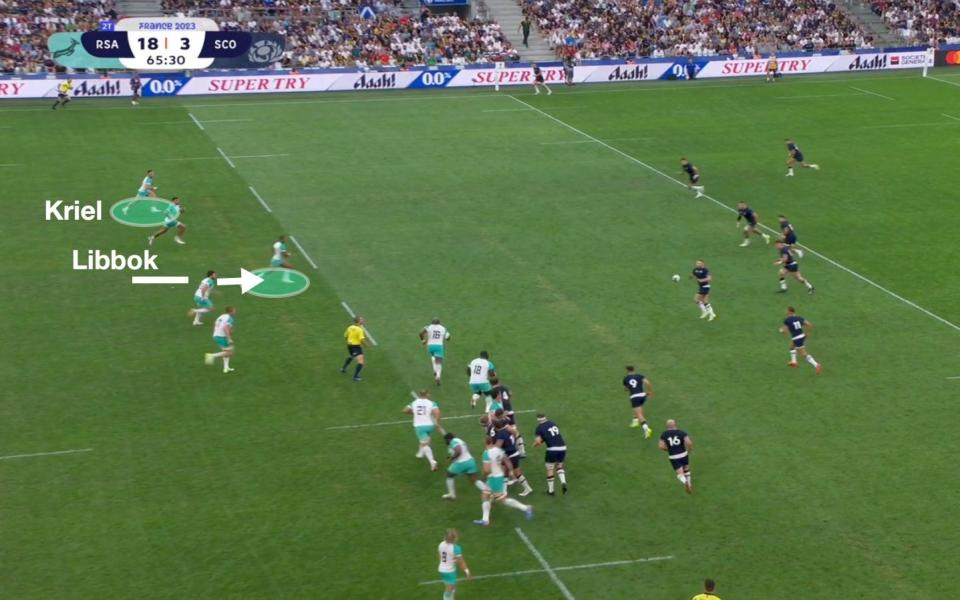
Once the chip comes, though, Kriel slams on the brakes and beats Huw Jones to the ball:

South Africa’s defence worked fantastically in this game, with different facets – pressurising playmakers, targeted line-speed, heavy tackling and breakdown disruption that pushed the boundaries of legality – complementing one another.
England will aim to implement a similar approach, underpinned by a patient kicking game and line-out nous, two renowned areas of strength for teams coached by Steve Borthwick. Henry Slade’s anticipation and conviction in the 13 channel, as well as how the England wings follow up behind their outside centre, are sure to be pivotal.
Borthwick cannot pick Franco Mostert, Faf de Klerk, Jesse Kriel, Cheslin Kolbe or any of the Springbok blitzers. That said, he does enjoy tailoring game plans to opponents and will have had two weeks to dedicate to this game. Felix Jones is in his corner, too.
Scotland will, of course, have learned from that defeat in Marseille. If the England defence is tentative or inaccurate, Finn Russell will pick it apart. Remember the pass to Huw Jones in 2018?
The sizzling try that Scotland scored against France was instigated by a Ben White box-kick, with Scotland winning the ball back and then spreading it before their opponents could regain momentum:
Amid other delicious subplots of the Calcutta Cup, a battle between Russell and the defensive system of Felix Jones promises to be captivating.

 Yahoo Sport
Yahoo Sport 





































